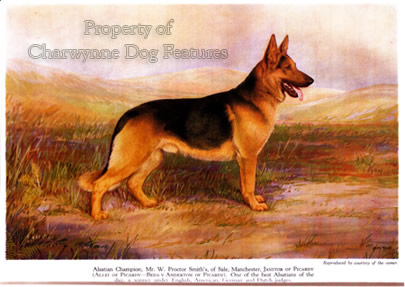914 GAIT-WAY TO BAD MOVEMENT
GAIT-WAY TO BAD MOVEMENT
by David Hancock



A century ago, all over Europe, the breed of dog most admired for movement, soundness of anatomy and sheer style of movement, was the Alsatian, now known as the German Shepherd Dog. Breeders in the other breeds envied their topline, their effortless gait and the functional excellence of their construction. The breed became, on sheer merit, the preferred choice of police forces and armed services of most European nations, as well as those of Japan and the United States. The GSD or Berger Allemand once put into the shade the other continental 'berger' breeds, especially those of Belgium, Holland and France, with their shepherd dogs, especially the once highly-favoured Beauceron of France, despite its many qualities, all but disappearing. Not any more! The Belgian Malinois has replaced the GSD in quite a number of countries and here, in desperation, our Thames Valley police force, for example, has had to breed their own 'shepherd dog' out of sheer need - as was the East European Shepherd Dog. At Crufts in 2016, the winning GSD drew widespread criticism amid accusations that the winning dog, a champion, was actually a canine cripple. What a descent for such a magnificent breed of dog!
But once the show fraternity get their hands on a breed and exercise their own prejudices, as opposed to the long-established needs of the farmer, any pastoral breed can be destroyed. Once you narrow down the gene-pool by excluding certain colours, already in the gene-pool, you weaken a breed too. White, cream, merle or solid-black GSDs do not appear in today's show rings, despite the sound sense of their inclusion; human whim decides all! Genetic health and provenance matter little to show ring zealots. If you add to that, the weird desire for the contemporary GSDs to have to move as no ancestor of theirs did, and indeed no other breed of dog does - the 'gaiting fad' - then breed destruction is on the way. Breeding a dog so that it has to move in a novel but entirely unnatural manner leads to idiotic and dangerous changes in its anatomy: a 'banana' back, excessive length of hindquarters and a weakening in every component of these physical areas. For such idiocy to be planned, then condoned by kennel clubs, is almost beyond belief. But it happened!
The harm done to the GSD breed by misguided faddists is incalculable. In their important book on the breed, The Complete German Shepherd Dog of 1983, breed experts Nem and Percy Elliott wrote: “The breed definitely went wrong of that there is no doubt. To get things back on an even keel, is what’s necessary, i.e.: back to the balanced dog, of correct type. For some that is not enough. They wish to continue to exaggerate their breeding plans; but in the opposite direction! Consequently, there are those who wish their dogs to be shorter than normal, with sloping and raised backlines, half-starved during puppyhood so as not to be too heavy; and this is equally wrong. Those of us with the necessary experience, have to continue to try and guide the development of the breed on the right lines. I think we shall succeed, but time will tell.” This makes sad reading and I wish them and their enlightened colleagues eventual success. No farmer could afford to breed deformed dogs! And no police force would want to use them.
Dissatisfaction with the GSD of today has led to healthier, sounder and ironically more typical versions of this famed type. The fanciers of Shiloh Shepherds, King Shepherds and Saarloos Wolfdogs are only doing what our distant ancestors did, seeking an unexaggerated, soundly-constructed, virile breed and not just marching in step with the others. I mourn the loss of the impressive GSDs of my youth, displaying a level topline and a hindquarter that would not disgrace a Foxhound. Half a century ago, some GSD breeders decided to lengthen the back, despite the evidence from America and experience from service dog users. Breeding for excessive angulation in the breed too has combined to produce poor movement, cow hocks, spinal problems and disc-size difficulties. Once, when working in London thirty years ago, I walked behind a Met police-GSD and its handler, for the best part of a mile. The hind movement of the dog was simply appalling. The dog reflected the faulty thinking in the breed at that time, time for a nonconformist, a kicker against consensus, to step forward!
I have every sympathy however with an all-rounder-judge, not a breed specialist, when faced with a GSD in the ring, displaying a curvature of the spine, a noticeable falling-away at the croup and one rear pastern resting wholly on the ground, as weirdly accepted as desirable in this once-impressive breed. Does this judge dismiss the exhibit from the ring as 'unsound', (as it clearly is) or condone misguided fashion at the expense of the breed's future? The dog could be a champion! It would have been bred and trained to 'stand' in the ring in this entirely unnatural posture, one not normal for any other breed and not part of this breed's past, as every archive image reveals. It is surely doubly regrettable when a breed is handicapped by its own fanciers. When such a dog appears at Crufts, the general public see on TV a handicapped dog, with the handicaps approved indirectly by the KC. Situations such as this simply have to be ended! This fine breed deserves better - much better. Gaiting must be gated!